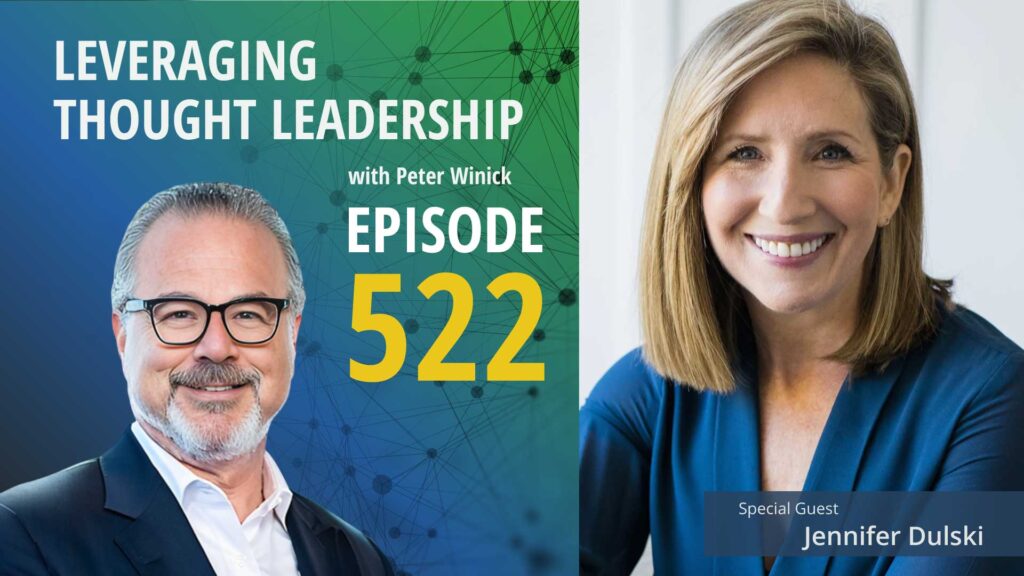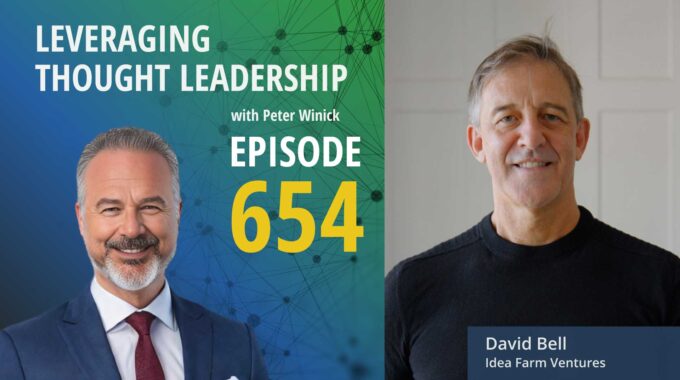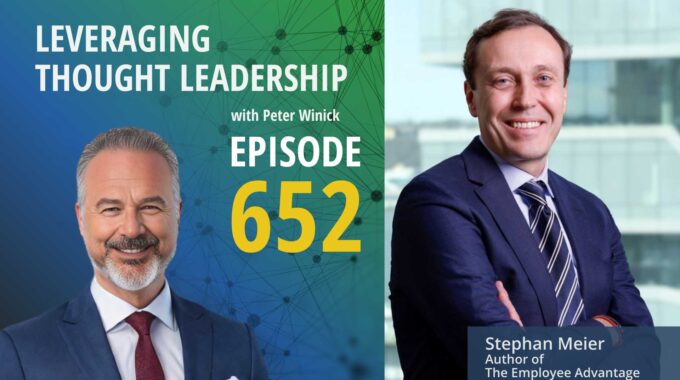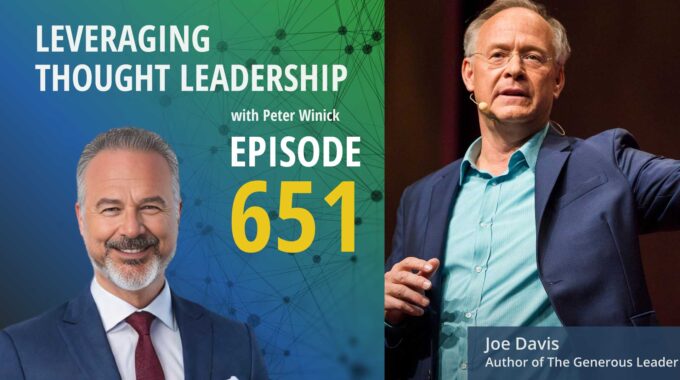Turning frameworks into funding: The hard truth about scaling thought leadership. This episode explores how…
Scaling Ideas for Impact | Jennifer Dulski

Using technology to take ideas to scale.
An interview with Jennifer Dulski about taking ideas to scale through publishing, social media, and technology.
Thought leaders are often torn between scale and depth.
Scale allows you to reach a large audience, while depth allows you to have massive impact.
So, where’s the happy medium?
Today’s guest is Jennifer Dulski, the CEO and founder of Rising Team which blends experience and science to help leaders ensure people on their teams feel valued, motivated, and connected. In addition, she is the bestselling author of “Purposeful: Are You a Manager or a Movement Starter?” The book provides invaluable resources for leaders who want to step up and make a difference.
Jennifer has had several roles in her career from entrepreneur for a non-profit start-up, high school teacher, and executive leadership roles at Facebook, Google, and Yahoo. We learn how all these roles have given her the experience to take her passion for creating a happy and successful high-performing team to scale using technology.
Often thought leaders believe they must stick to a single domain, but Jennifer shares how her varied career has allowed her to adjust, grow, and change her domain expertise over time as her own experience has developed through both success and mistakes in the field.
Our conversation wraps up by discussing putting content into various modalities and how using LinkedIn, being an educator, and writing a book all play together. Jennifer explains how the book and book talks helped to tighten up her content and give her credibility while bite-sized portions of that content go out on LinkedIn to have larger engagements with her audience.
Jennifer shares useful information on taking ideas to scale and leveraging a book to create a deep impact on your audience.
Three Key Takeaways:
- You don’t have to be a thought leader in only one domain. You can grow your thought leadership in multiple domains as your experience grows.
- Having successes and mistakes are both part of the thought leadership journey.
- A book can help you solidify your ideas and present them in the clearest way, which you can then build additional product offerings.
If you need a strategy to bring your thought leadership to market, Thought Leadership Leverage can assist you! Contact us for more information. In addition, we can help you implement marketing, research, and sales. Let us help you so you can devote yourself to what you do best.

Transcript
Peter Winick And welcome, welcome, welcome. This is Peter Winick. I’m the founder and CEO at Thought Leadership Leverage and you’re joining us on the podcast today, which is Leveraging Thought Leadership. And today my guest is Jennifer Dulski. She has a wide range of executive experience, including leadership roles at Facebook, Google and Yahoo! She’s been a founder, CEO and president, early stage companies that have been scaling up. Prior to Rising Team, she led Facebook groups, which was used by more than a billion and a half people. She was president and CEO of Change.org. The list goes on, including being a guest lecturer at Stanford. But given that she’s with us right now, I’d rather just talk to her directly. So welcome, Jen. Thanks for coming on board.
Jennifer Dulski Thanks for having me, Peter.
Peter Winick So talk to us a little bit about your journey as a thought leader, right, Because you’ve gone from executive, nonprofit, building movements, author, speaker, how does it all how is it all tied together for you?
Jennifer Dulski So for me, there’s sort of two threads through my career. The first is about my own personal search to create impact at scale. And it started very early in my career. As you mentioned, I started a nonprofit to help kids become first generation college students. And I also was a high school teacher for four years. And the reason I got into tech was because I saw the kind of impact we could make at a nonprofit. And it was very linear scale. And I thought technology would help us scale that at an exponential level, which it clearly has. So that’s sort of the first thread. And the second thread, which has led me to the company that I’m leading now, is that my personal passion and superpower has been all about how do you create really happy, successful, high performing teams? This has been true since my early days as a coxswain on the rowing team, which is where I believe I learned all my leadership skills and now in a rising team is essentially scaling that superpower so that every leader on earth can run a happy, successful, high performing team. So those are the three lines. And the thought leadership piece sort of has come along the way. You know, as you get to be more and more of an expert in something. As it turns out, people want to learn from what you have learned. And I have my fair share of both successes and plenty of mistakes to share. And that’s been part of the thought leadership journey.
Peter Winick Now, I love that. So one of the things that I love about your journey is that it’s been pretty eclectic, but oftentimes folks come coming at it from either a strictly academic perspective, which means everything works fantastically on paper. But if you take it out in the world, maybe not so much, then there are people that come at it as the, you know, from the outsider coming in or consultant. So they have a framework, a model, a method. They come in, they do their thing, and they leave an on operating side of businesses for a long time and came to the epiphany, if you will, about, you know, it’s all about high performing teams and then sort of made that the thing that the thought leadership hangs under that a fair.
Jennifer Dulski That’s right. And it’s interesting because there’s been various different parts of thought leadership through my career and that’s one of the big learnings that I’ve had is people don’t need to look at thought leadership and think I have to pick only one thing and I can only be an expert at only one thing for my whole career. The truth is we learn from our own experiences and those around us and we can build thought leadership around different pillars as our own experience grows. So, you know, early on I was the thought leader in the Internet in general because I was one of the very early people. You know, I started at Yahoo. I was number like 400 employee. It was, you know, the Internet was just dawning. I remember when we created Search Engine, we created instant messaging and all of this. And so there was thought leadership there. And then as make sure.
Peter Winick That let me finish a little bit. Let me just push back on that, though. I think at any given time frame, it’s important that a thought leader does stay in one lane. Right. So when you were talking about the Internet 20 some odd years ago, whatever, that’s different. There are very, very few people understanding what it was and how it works and what will happen. You know, it’s like right now everybody’s ChatGPT-ing and AI-ing everything. Right? And so it’s sort of that. But I think when it comes to leadership at a point in time, whether that’s a year or five, eight, you have to stay in your lane. And I think it’s really tempting for smart people that can have lots to say about lots of different things to spread themselves too thin because it does dilute the efficacy of the gravitas of the followership.
Jennifer Dulski I agree with you 100%. I’m not saying you should be try to be a thought leader on everything all at once. It’s not like the movie, but it’s more that things change over time. And so your thought leadership message may also evolve over time. So I had one message as we were talking about in the kind of late nineties, early 2000. Then I ended up becoming president of Change.org. And for five years I, you know, helped amplify people’s voices all over the world and started to understand what it took to actually for regular people to create change in the world. And I learned so much that I ended up writing a book about that. And the reason my angle was unique on that book was because I not only had the experience leading Change.org, but I had had ten, 15 years in tech before that. So the thought leadership was actually what are the similarities between these two worlds and what can we all learn from them together? Yeah.
Peter Winick Yeah. And I think that that’s in. Sting. And I think that a lot of people, not a lot, but a lot of thought leaders try to figure out, well, what’s my path, What’s my lane? Right? So I’m in the leadership in the management space. And so what? There’s 100,000 other people that are in that space, but what you just described is sort of the I can’t help it being a consultant, but the Venn diagram. Right? So you had that overlap of the scale and said, Oh, that’s my special sauce. And anytime you could sort of cross-pollinate two disciplines from a unique perspective, the fine that is, is really that will get a reaction good, bad and ugly. But it’s a unique perspective. It’s not the 17th flavor of management. What I want.
Jennifer Dulski That’s right. That’s absolutely right. And as we said, all of that has led to what I’m doing now, which I believe is the culmination and is probably perhaps the thought leadership space I should have been in all along, which is about, you know, creating, as I said, these really happy, successful teams. And so sometimes it’s also even if you if you want a lane or you want a path, sometimes you’re not quite ready day one to start on that path, you have to build on the experience and the knowledge you have today and then build on that over time.
Peter Winick When sometimes you might not realize it’s right in front of you. Right? So I would argue that if you and I were having a long conversation and it started with your career early on, tell me about, you know, a great team. You’re on a good team. Like there’s probably a theme of the best moment in your career were ran in parallel to when you were leading or part of the greatest teams in your career.
Jennifer Dulski That’s true. You are right. And so a good, you know, mentor consultant like you can help someone uncover that. And yes, it did lead me to ultimately start an entire company around it. I think the voice that I have now on this topic is much more credible than I would have had, you know, 15, 20 years ago. And partially it’s because I felt the pain in myself. Right. Like some of some of this comes from feeling pain. And for me as a leader, I always felt like, gosh, no matter how much I learned, no matter how many thought leaders I was exposed to as coaches and trainers and so forth, I always felt like I was being taught to fish and then going back to the lake with like a binder instead of a fishing pole, because I wanted, you know, tools to bring those things to life with my teams. And so that’s what I was missing. And, you know, today what I’m building is a combination of those things. It’s the knowledge and the thought leadership combined with the tools to help people do it themselves. And to me, that’s really the secret sauce here in thought leadership in general. My vision.
Peter Winick Yeah, I like the concept of the you know, there’s a place for the theoretical in the place for the applied, you know, when you go on the fishing boat with the binder, not so helpful. Right? You know.
Peter Winick If you’re enjoying this episode of Leveraging Thought Leadership, please make sure to subscribe If you’d like to help spread the word about our podcast, please leave a five-star review at ratethispodcast.com/ltl and share it with your friends. We’re available on Apple Podcasts and on all major listening apps, as well as at Thought Leadership Leverage dot com forward slash podcast.
Peter Winick Let’s segue for a moment or two into the business side of this. Right? So as a thought leader, the product you create comes from your mind, comes from your research, comes from your experience, etc.. As a teacher that you said, you know, you’re early in your career, that’s also kind of non scalable. How many people can you touch? But now you’ve got this tech thing going on where everything that you do is about scale. So how do you most effectively scale your ideas for impact and or income for revenue generation?
Jennifer Dulski Well, it’s so interesting. I’ve thought about this differently at different times in my career because there’s breadth, you know, scale, breadth, revenue, and then there’s depth, which is how deeply do you touch and impact individual people. And so really in my career when I taught high school or when I started that nonprofit, I knew for sure that we were massively impacting people’s lives. Like I could see students in seventh grade who would get on the path to college, they would graduate college, and they would alleviate poverty in the family, you know, for generations to come. And at this end. So that was really meaningful to me. And at the same time, I could only do so many people, you know, I just did not scale at that depth. And so I got into tech, as I said, and thought leadership in general writing a book. And, you know, I’m a LinkedIn influencer and I teach at Stanford now. And so all of that was about well, most of that has been about scale. How do you reach more people? And much of that has come, you know, with business attached to it. I have been I know there are a lot of thought leaders who make their entire living off of speaking fees and so forth and books. And I do some of that. That’s not how I make my primary living because I like to build products that scale. And so whether it’s working at a large company and running a big team there or doing what I’m doing right now with Rising Team, like my belief or my vision for Rising team is every team on earth like we are already on six continents, We’re already at giant tech companies and small nonprofits and schools. And if I can scale this to. You know, millions of teams using it. To me, that’s the most fulfilling part. And the revenue side will come along because we’ll be building a scalable large business, which will hopefully make a lot of money not only for me, but for my investors and for my team and so forth in the process of creating impact. I have found, though, that I still like the depth as well. I love the breadth, but I really like the depth. That’s why I started teaching again at the Gsb at Stanford, because I like to have students and I do that also with my own team. It’s why I like building companies and teams and companies.
Peter Winick Yeah, no. And a couple of things you said that were interesting was, you know, hey, you know, I put stuff out there in a book form. I put it out there at Stanford, I put it out there on LinkedIn, I put it out there. I get paid a lot to put it out there inside of large organizations. And oftentimes people hear that and they go, Oh, so there’s ten different things she’s putting out. And I would push back and know you’re putting out the same ideas in different ways, in different contexts, at different price points from zero to a lot. Right. Think it’s a little bit counterintuitive, but I would argue that like not holding your best stuff back on LinkedIn and saying, you know.
Jennifer Dulski By my book, right. I mean, you know, I also say it is so true. So first of all, yes, I agree it’s this it’s similar messaging. It’s the same themes are in all the locations. It does evolve over time. As you know, for instance, now, there’s, as you pointed out, is now in the conversation, which wasn’t a few years ago. But the interesting thing some of what people think I think can be misleading. Like most people think, oh, my gosh, you write a book like that’s where you make all the money and that’s where you get all the exposure. Way more people will read what I write on LinkedIn than will ever read my book. I have single posts on LinkedIn that have been read by more people than have read my book.
Peter Winick So but there’s a relationship between the two. So when you look at that. And you apply some metric. You say, Wait a minute, I spent a year of my life and all this time and all this money and I sold 12,000 copies, whatever your numbers, Right? Jeez, that was a lot of work. And you go, Then I just came up with this idea, and it took me 20 minutes and I filled with it and blah, blah, blah, blah, blah. And I got it out there and, you know, it got it got shared 113,000 times. Well, logic would say we’ll just do more of that. But the book gives you the foundation, the platform, the grounding to say, why should anyone listen again? Right. So, yeah, absolutely.
Jennifer Dulski And I, I actually loved writing the book. And I at some point I’m sure I’ll write another book, but they just have different purposes. And, you know, it’s interesting for me, one of the things I think about the book is it’s again, it’s death versus breath. So the book is much deeper. Fewer people read it, but they will get way more out of it. And I have had so many people come to me and say, I changed my career or I started this thing because I read your book and I thought I could do it. And that isn’t going to happen necessarily from any one post you post anywhere, you know, or things like that. So there’s a reason to do it. And I also in some little way, I think that books are a really nice legacy. You know, I think about my daughters, for instance, you know, like they can go back and listen to me on the audiobook whenever they want after I’m gone. And that’s, you know, it’s not why I wrote the book, but it’s a nice plus.
Peter Winick And it also forces you to take the stuff that’s rattling around in your head and get it out there in a clear and concise way, because I’m sure you’ve written chapters apart and said, Oh, I thought this was the best way to say what’s the best way to say it? So it is it does help you get it out there really clearly, which serves as a foundation to build products, offerings and services offer something that’s pretty tight.
Jennifer Dulski Yeah. You know, what’s interesting is my major lesson was that I did a lot of that with the book. You’re right. And I reworked it and I had a lot of help from editors and so forth. And when I started doing the book talks, it got even tighter. In fact, I have seven chapters and seven main themes in the book. And when I started doing the book talks, I realized I could collapse it into only three things and they much more memorable because they also all start with the same letter. And so I thought, Oh gosh, now when I advise people, or if I think about my next book, I would write the book talk first, and then I would go back and write the book.
Peter Winick Well, it’s interesting because there’s two schools of thought there. I don’t think one’s better than the other. But there’s the book that becomes, you know, the TED talk, if you will, give me, you know, 60,000 words and give me the 15 minute highlight reel. And then there’s the idea that starts small as an article or a talk or something, and then the market respond and says, Tell me more, tell me more, tell me more. One again, one Is it better than another? It’s just an interesting way that how do ideas get developed and matured and nurtured when you start? Little like I always look at LinkedIn and those sorts of places as they’re basically laboratories because as the thought leader, we’re pretty awful at predicting like when we hit that published or send button, like, Wow, that’s the greatest thing I ever wrote that’s going to be awesome versus I don’t know if I don’t even know if I can send on that one. It’s not that great. It’s not my sharpest tool or whatever, whatever. And that’s, you know.
Jennifer Dulski Do you know what’s the most popular post you’ve ever done?
Peter Winick I should know that I used you know, I don’t. I think I do, actually. Yeah.
Jennifer Dulski What was it?
Peter Winick So I did a piece. It was something along the lines of, you know, Field of Dreams, great movie, stupid strategy, because I was tired of hearing people tell me building. They will go, Oh, I just spent all this money building this thing and that thing and doing that. And it’s like, and then they will come, right? Like, not so much.
Jennifer Dulski Yeah, I love that. I actually I because I have a newsletter on LinkedIn, also called Leadership Is Everywhere. And it’s all about leadership lessons from pop culture. And so I love that field of dreams. And actually up until recently, the most popular thing I had ever written was a piece I wrote about my dad on Father’s Day. I wrote a piece called Don’t Work with Jerks Five Lessons I Learned from My Dad. And I just took it as kind of an ode to him, and that thing went crazy. It was like the top list on LinkedIn was like Bill Gates, Richard Branson and me about this article about my dad. But since then, I think I’ve had I wrote one about lessons from Top Gun Maverick, which also showed up being super popular and picked up in the Financial Times. And so, yeah, you can’t predict some of what I do, I just do because I find it interesting and compelling and or sometimes I literally can’t not write it. Like that’s how I felt about this maverick piece. I just was in my head. I had to get it out. You know, I think.
Peter Winick We have a responsibility to put a disclaimer because I don’t want to be even partly responsible for a thousand more articles on Barbie and management or something.
Jennifer Dulski Yes, that’s true. Yeah, that’s fair.
Peter Winick For Barbie to.
Jennifer Dulski That’s true. We are buried out. And I don’t I’m not suggesting that the way to get a lot of, you know, people following you is pop culture. It’s more just sometimes, you know, sometimes thought leadership can happen because you have something that you’re really trying to teach. And sometimes it can happen because you just have something that you find personally interesting or compelling and you want to share that. It doesn’t always.
Peter Winick Happen. That personally interesting thing and you alluded to it in a little bit of a different way earlier is, hey, was a problem a pain that I had? Right. So we’re much more. Interested in solving a problem or a pain than we have then some theoretical academic whatever. You know, so I would be thinking about, you know, what’s the thing that keeps you up at night? And there are there people like you that would pay a premium for that to solve that problem or fundamental mousetrap forward or whatever the case says? Well, this has been fun. Any final words or thoughts or pearls of wisdom? Note No pressure, but people are waiting with bated breath for something.
Jennifer Dulski Well, I’d say, you know, the major lesson from Purposeful, which is the book that I wrote, is that, well, I’ll tell you the three things, right? This is as it turns out, it boils down to three things courage, community and commitment. And I think this is true for thought leadership. Two, the first pieces just get started. Like, this is the thing that holds most people back is they just don’t they’re afraid to do anything. And the truth is that the biggest, most world changing movements all start with just one step. You know, you don’t have to write a book. You just have to put something out there. Even just write it to yourself, write yourself. An email like that may be enough of a starting point. Yeah. The second community, which is you can’t do this alone, thought leadership. You can do more alone than many other things, but you will be better if you invite others to look at your work, give you feedback, help you, etc. And the third is commitment. Because sometimes these journeys are hard. They don’t always go well. Not everything is a success. A success. And so the people who are the most successful in the end are the ones who just keep getting up and trying it again.
Peter Winick And I think that a community and commitment piece are related because we will disappoint ourselves by not finishing something. But the more you’re engaged in a community and I, I agree that thought leadership is an individual sport, but it’s actually better played as a team when you engage others and to bounce ideas off of etc., it’s going to force you to get then the next draft to polish it more to get, you know committed.
Jennifer Dulski Absolutely. So it does make you more accountable, as you said.
Peter Winick So yeah, Well, appreciate your time. This has been great. And thank you for spending some time with us today, Jennifer. Appreciate it.
Jennifer Dulski Thanks, Peter.
Peter Winick To learn more about thought leadership leverage, please visit our Web site at ThoughtLeadershipLeverage.com to reach me directly. Feel free to email me at Peter at thoughtleadershipleverage.com and please subscribe to Leveraging Thought Leadership on iTunes or your favorite podcast app to get your weekly episode automatically.





